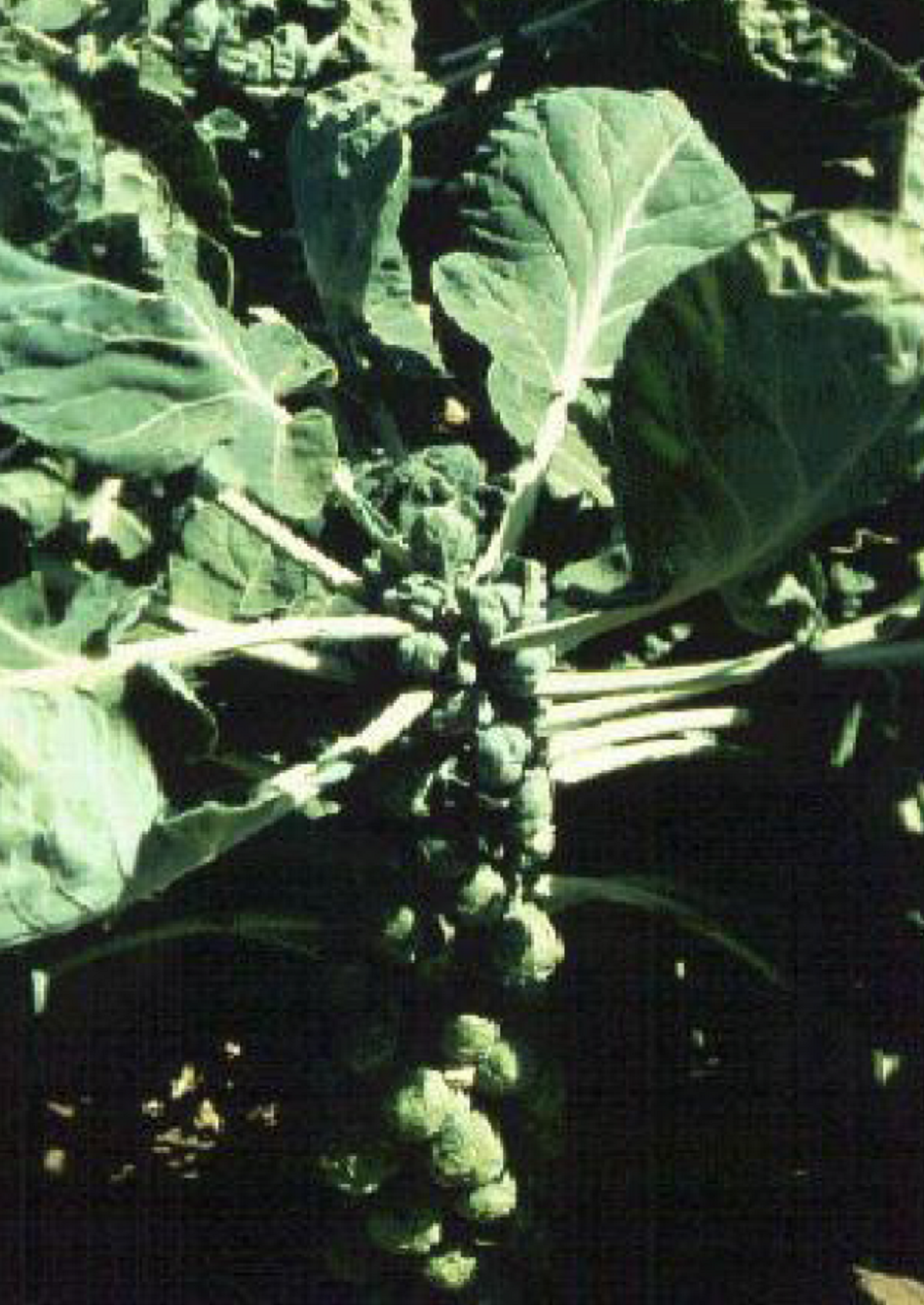
by Ray Bodrey | Nov 14, 2016
Want to try something different in your winter garden this year? Well, when it comes to Brussels sprouts, you either love them or hate them. They’re not commonly grown in the Panhandle, but if you’re looking for something different, try growing this tiny cabbage. Predicted weather conditions for this season should lend a great crop.
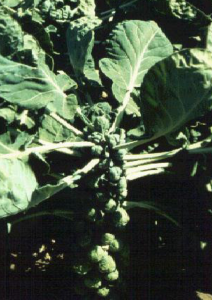 Brussels sprouts are very popular in Europe, especially Great Britain, but not so much here in the U.S. However, they are grown commercially in California and New York. But, most states have a limited market and these crops are mostly seen in backyard vegetable gardens. The two varieties, Jade Cross and Long Island Improved, are the most commonly grown in the Panhandle.
Brussels sprouts are very popular in Europe, especially Great Britain, but not so much here in the U.S. However, they are grown commercially in California and New York. But, most states have a limited market and these crops are mostly seen in backyard vegetable gardens. The two varieties, Jade Cross and Long Island Improved, are the most commonly grown in the Panhandle.
Brussels sprouts are actually a type of cabbage. However, the plant does not form one large head in the center, but rather many small heads on lengthy branches. Each golf ball size sprout resembles a cabbage head. Brussels sprouts require extended cold, dry weather, just as many sources have predicted for this year in the Panhandle. Brussels Sprouts can also survive a heavy frost. They’ll need a temperature at least in the lower 60’s in order to maintain a solid sprout and not open up. If sprouts open, structural integrity is lost, and the sprout will turn to mush.
Finding Brussels sprout transplants for your garden may be a challenge. They’re just not that popular. The good news is, seed is readily available and germination is quick once planted in garden soil. Seeds should be planted between October-December in the Panhandle. When planting, space approximately 2 ½’ apart within the row at a seeding depth of a ½”. Rows should be 2’ apart. It’s a good idea to fertilize before you plant with a general all-purpose fertilizer like 10-10-10 or 8-8-8. A good rule of thumb is to disperse 4 pounds of fertilizer per 100’ row. Once plants have grown a few inches, broadcast another application and apply a water afterwards. After a month, another application should be done. Plants should reach maturity at three months. First sprouts will develop on lower branches. Once sprouts are golf ball size, they’re ready to pick.
As far as pest management, the most common issues with Brussels sprouts are the same with any cabbage. Aphids, nematodes and cabbage worms pose the greatest threats. If these pests appear, it’s usually later in the season when the plant is closer to maturity. At that point, you should apply a common vegetable garden pesticide, one that can be used with any variety of produce. As always, be sure to follow the manufacture’s label directions when using chemicals.
Brussels sprouts are high in nutritional value. According to the USDA, a sprout has approximately 10 calories, and is high in both dietary fiber and vitamin C. Here is a challenge for readers who are not fans of the tiny cabbage. Fair warning, this challenge is under the premise that additional calories are acceptable. Start by sauteing a dozen or so Brussels sprouts in equal parts olive oil & butter. Once the sprouts have become a bit tender, add a generous amount of Parmesan cheese and bacon bits. Plate and dig in. I’m confident that this will change some minds.
For more information, contact your local IFAS Extension office
Supporting information can be found in the UF/IFAS EDIS publications, “Brussels Sprouts-Brassica oleracea L. (Gemmifera group)” by James M. Stephens, & “Florida Vegetable Gardening Guide” by Sydney Park Brown, Danielle Treadwell, J.M. Stephens and Susan Webb.
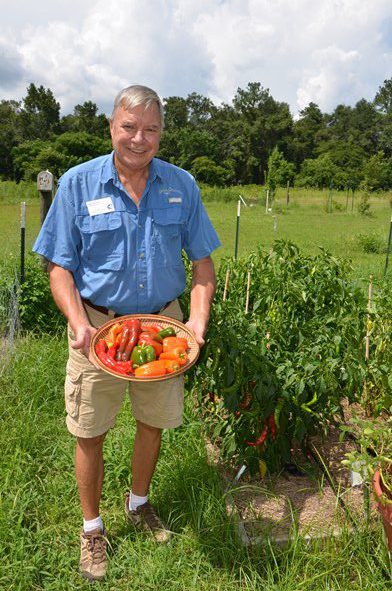
by Les Harrison | Nov 3, 2016
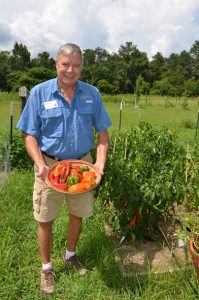
Wakulla Master Gardener Bill Osborne shows off some of the peppers he grew.
Vegetable gardening has many highly desirable benefits. These positive features range from being a good source of exercise, an opportunity to produce fresh produce which may be hard to find in retail establishment, and being able to assure it is produced in a specific way.
In many cases it is difficult, and sometimes tedious, to place an accurate assessment of the economic value on producing vegetables for home consumption. Household budgets in 21st century are problematic enough without literally bean (or some other vegetable) counting to measure profit or loss in the home garden.
As part of an effort involving UF/IFAS Wakulla County Extension Master Gardeners, some popular vegetable categories have had their production assessed. All were grown in the demonstration garden at the UF/IFAS Wakulla County Extension Office on Cedar Avenue in Crawfordville and Master Gardener Bill Osborne coordinated the project.
Several pepper cultivars and an heirloom squash cultivar was chosen to assess. They were selected based on their potential for producing over a long period of time during the summer months.
For the home gardener this means the potential for of eating fresh produce as it matures all season long. It minimized or eliminates the need for preservation expenses, which add to the cost of home production.
Each plant was grown under identical conditions in mushroom compost. The production would qualify as organically produced, but this was not part of the original assessment objective even though it would raise the end value of the useable vegetables.
The cost of the raised growing beds calculated out to approximately $15 per plant, but the expense could be spread over several years. This would reduce the annual expense to about $5.00 per plant for necessary growing inputs to establish the garden.
Values are always a tricky component to establish and necessitate certain assumptions. The prices used in this study were a composite of Big Bend area grocery store and super market prices. Each was rounded to the nearest quarter-dollar to keep calculations simple.
The results are reported on the chart included with this story. The big winner economically was the lemon squash with a retail squash prices averaged $2.25 per pound.
If consumed fresh, each lemon squash plant produced a $65.25 value with $5 of expense. The home gardener netted $60.25 saved in their food budget
Conventionally-grown specialty peppers averaged $4.50 per pound, with organic receiving a much higher price. The big economic winner was the Giant Marconi cultivar producing 10.5 pounds. When expenses were removed, the plant produced $42.25 of retail value.
Close behind was the Mesilla cultivar with 10.12 pounds of production. Its retail production value netted to $40.50 per plant.
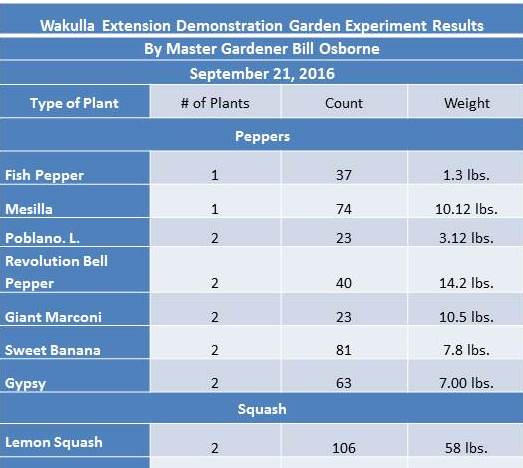
While eating fresh vegetables is a healthy practice, successfully growing them can be a helpful practice for the family budget.
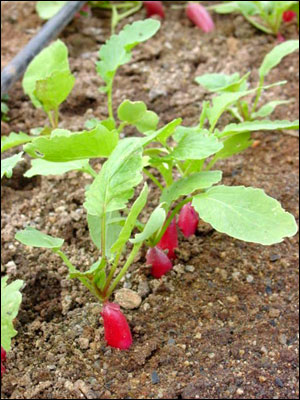
by Julie McConnell | Nov 2, 2016

Radish. Photo credit: UF/IFAS Gardening Solutions
If you’ve considered starting a vegetable garden but are intimidated by the idea, this time of year is a great time to give radishes a try. Radishes are a cool season crop and will grow well in the mild winter climate of North Florida. The ease of growing this cool season vegetable also make them an ideal starter plant to get kids interested in gardening.
Radishes germinate with soil temperatures of 45-85⁰F and grow well when temperatures average 50-65⁰F, so October to November is a good time to plant in the fall. They develop quickly and are ready to harvest in as little as 3-4 weeks, so the quick results keep children interested.
Don’t have a garden area setup yet? No problem, grow radishes in a container! They take up very little space both in width and depth and can be easily grown in a modest sized pot. Radish seeds are small so should be planted very shallow, only cover with about ¼” of soil. Space plants about 6 inches apart and stagger planting dates through the fall and winter so that you can harvest as needed and still have a new crop coming on. For best flavor and texture, harvest when radish roots are ¾ inch diameter or less.
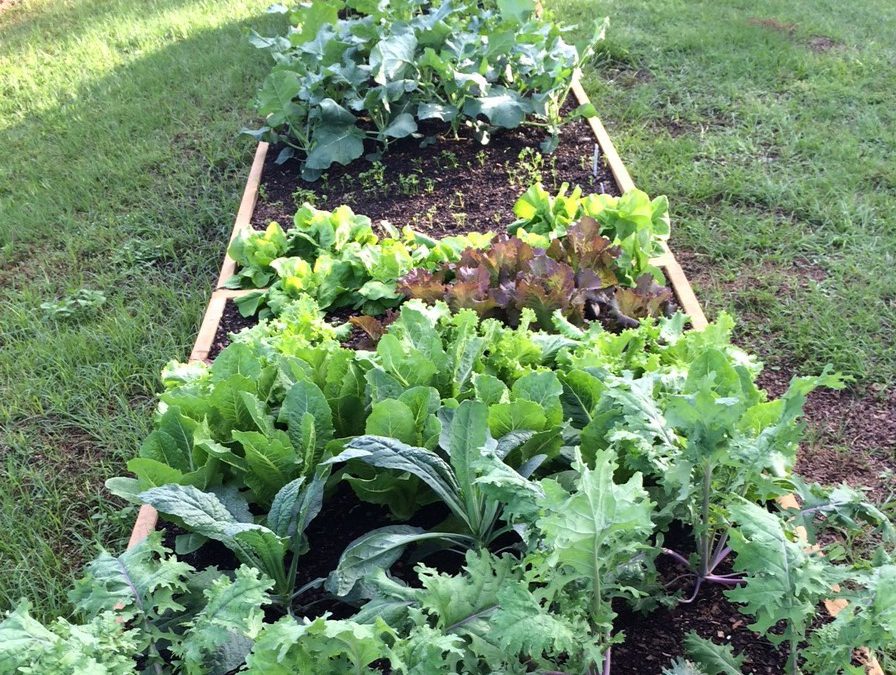
by Molly Jameson | Sep 16, 2016
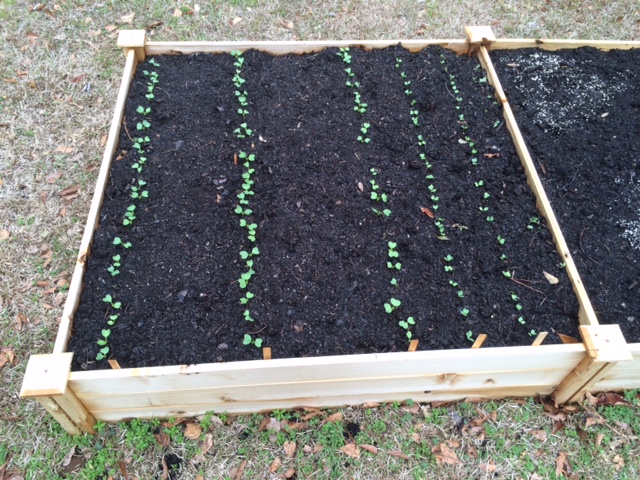
Direct seed root crops and many leafy greens, such as arugula and spinach. Photo by Molly Jameson.
Fall is fast approaching, and that means my favorite season for gardening has arrived! September is the month we get to start all of our fall favorites. For me, this means starting lettuce, kale, broccoli, and collards by seed in flats indoors. I use full-spectrum fluorescent bulbs, which mimics natural sunlight. In a couple of weeks, I will direct seed arugula, carrots, mustards, spinach, Swiss chard, and turnips into my raised beds.
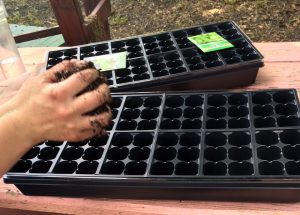
Seed brassicas and lettuce into flats. Photo by Molly Jameson.
But before I get started direct seeding, I will first need to do some garden cleanup. Sadly, this means I will need to say goodbye to my basil and okra, which are still hanging on despite the heat (and despite the hurricane!). Then it will be time to add a fresh layer of compost. Additionally, I will be adding worm castings, which I have been creating for my fall garden in my home worm bin all summer. There is no better feeling then growing brassicas and lettuce from seed, digging small holes, adding homemade fresh worm castings to each, and planting the eager seedlings.
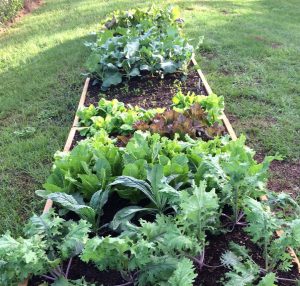
Grow a variety of greens for the fall season. Photo by Molly Jameson.
Fall is a wonderful time to garden in zone 8b – generally less pest pressure and a chance to plant hardy leafy greens that can be harvested all the way into spring. Of course, I always keep frost cloth around, in case temperatures dip below freezing for extended periods of time. In which case I will be sure to carefully cover my lettuce and Swiss chard, making sure the cloth is well secured.
I love my tomatoes, peppers, beans, and squash, but they usually involve staking and the ever imminent threat of caterpillars and intense heat. In the fall, most crops hold themselves off the ground, and I certainly cannot wait to pull on a jacket in the crisp early morning, come out to harvest kale and spinach leaves, and add them to my breakfast smoothie and veggie omelet.
For more information:
Florida Vegetable Gardening Guide

by Ray Bodrey | Aug 19, 2016
Being a gardener in the panhandle has its advantages. We’re able to grow a tremendous variety of vegetables on a year-round basis. However, in this climate, plant diseases, insects and weeds can often thrive. Usually, chemical measures are applied to thwart these pests. Some panhandle gardeners are now searching for techniques regarding a more natural form of gardening, known as organic. With fall garden planting just ahead, this may be an option for conventional vegetable gardeners looking for a challenge.
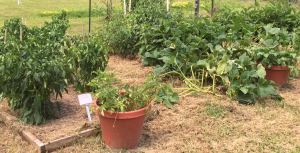
Vegetable Garden at UF/IFAS Extension Wakulla County. Photo credit: Ray Bodrey UF/IFAS.
So, what is organic gardening? Well, that really depends on who you ask. A broad definition is gardening without the use of synthesized fertilizers and industrial pesticides. Fair warning, “organic” does not translate into easier physical gardening methods. Laborious weeding and amending of soil are big parts of this gardening philosophy. This begs the question, why give up these proven industrial nutrient and pest control practices? Answer: organic gardening enthusiasts are extremely health conscious with the belief that vigorous outdoor activity coupled with food free of industrial chemicals will lead to better nutrition and health.
As stated earlier, the main difference between conventional and organic gardening is the methods used in fertilization and pest control. In either gardening style, be sure to select a garden plot with well-drained soil, as this is key for any vegetable crop. Soil preparation is the most important step in the process. To have a successful organic operation, the garden will require abundant quantities of organic material, usually in the form of animal manures and compost or mixed organic fertilizer. These materials will ensure water and nutrient holding capacity. Organic matter also supports microbiological activity in the soil. This contributes additional nutrients for plant uptake. Organic fertilizers and conditioners work very slowly. The vegetable garden soil will need to be mixed and prepped at least three weeks ahead of planting.
Effective organic pest management begins with observing the correct planting times, selection of the proper plant variety and water scheduling. Selecting vegetable varieties with pest resistant characteristics should be considered. Crop rotation is also a must. Members of the same crop family should not be planted repeatedly in the same organic garden soil. Over watering can be an issue. Avoid soils from becoming too wet and water only during daylight hours.
For weed management, using hand tools to physically removing weeds is the only control method. As for insect management, planting native plants in the immediate landscape of the organic garden will help draw in beneficial insects that will feast on garden insect pests. The use of horticultural oil or neem oil is useful. However, please read the product label. Some brands of oils are not necessarily “organic”. Nematodes, which are microscopic worms that attack plant roots, are less likely an issue in organic gardens. High levels of organic matter in soil causes an inhospitable environment for nematodes. Organic disease management unfortunately offers little to no controls. Sanitation, planting resistant varieties and crop rotation are the only defense mechanisms. Sanitation refers to avoiding the introduction of potential diseased transplants. Disinfecting gardens tools will also help. Hydrogen peroxide, chlorine and household bleach are disinfecting chemicals allowed in organic gardening settings as these chemicals are used in organic production systems for sanitation. Staking and mulching are also ways to keep plants from diseases by avoiding contact with each other and the soil.
Organic gardening can be a challenge to manage, but better health and nutrition could be the reward. Please take the article recommendations into consideration when deciding on whether to plant an organic garden. For more information, contact your local county extension office.
Supporting information for this article can be found in the UF/IFAS EDIS publication, Organic Vegetable Gardening in Florida, by Danielle D. Treadwell, Sydney Park Brown, James Stephens, and Susan Webb.
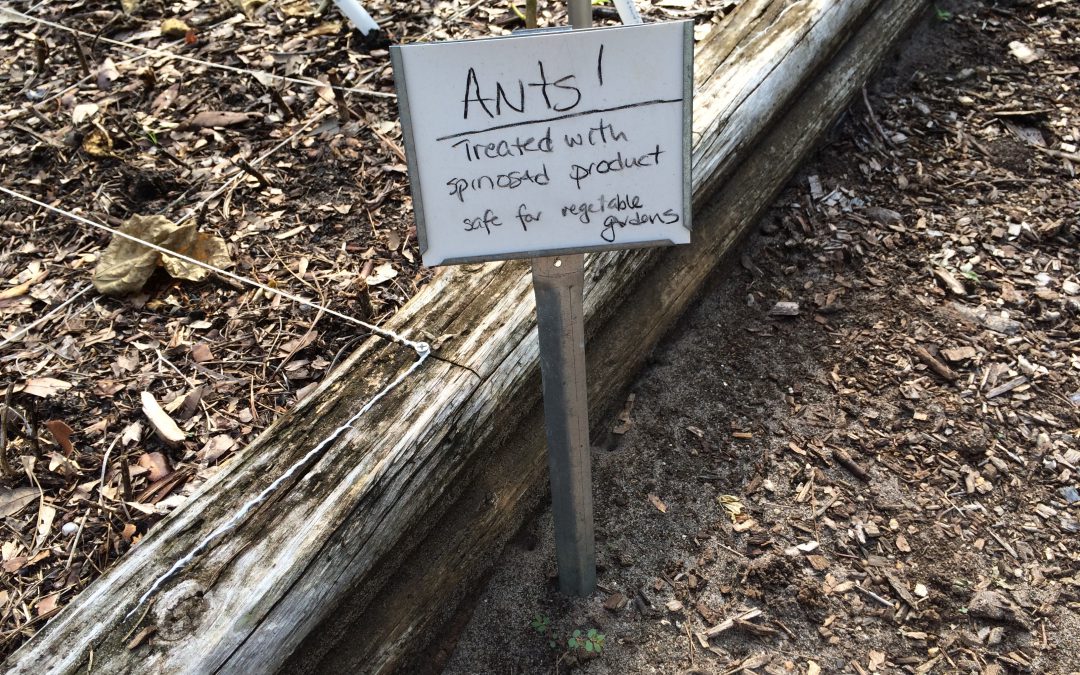
by Molly Jameson | Aug 12, 2016
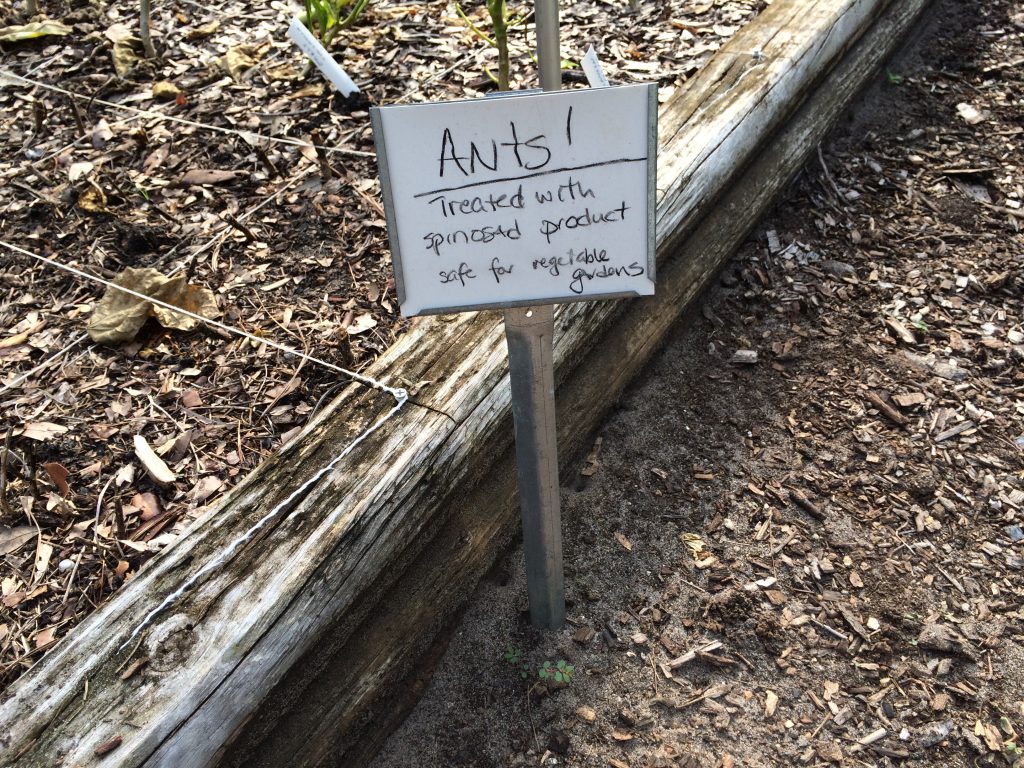
Ants can be treated with spinosad in vegetable gardens. Photo by Molly Jameson.
There’s nothing worse than sinking your fingers into your garden soil to dig up a potato, plant a seedling, or pull up a radish, and be met with a sharp, painful sting, and little red critters rocketing up your arms. If you are a gardener in the panhandle, my bet is that you know exactly to what I refer: fire ants!
Fire ants are certainly not native to our area. These guys are an invasive species from South America that are very resilient, and many are territorial, with the potential to drive out any native ant populations. Fire ants arrived in the 1930s, and can now be found throughout most of the southeastern United States.
So when you end up with fire ant mounds engulfing your carrot patch, what can be done? Since fire ants in your garden mean fire ants in your food, the least toxic control methods are of high importance and conventional broadcast bait treatments and mound treatments should be avoided. Even in your lawn, be careful when using strong insecticidal bait treatments, as these can harm the native ant populations that help control the spread of fire ants. This can then lead to a strong resurgence of fire ant populations that can outcompete the native ants.
Although completely controlling fire ants in an area is not possible, there are sustainable management techniques that can help. Some fire ant colonies have a single queen while others have multiple queens. Either way, in order to eliminate a fire ant colony, all queens in the colony must be killed. Fire ants are omnivorous, in that they eat plants, insects, sugars, and oils. The catch is that they are only able to ingest liquids, so solid food must be brought into the colony, where larvae regurgitate digestive enzymes onto the food, breaking it down into liquids. Therefore, any method of control by ingestion will need to be in liquid form, or the ants must be able to bring the material into the colony, without first being exterminated.
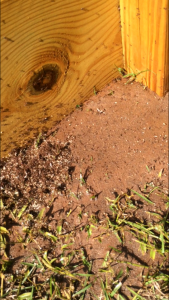
Fire ants can become a problem around and in raised vegetable gardens. Photo by Molly Jameson.
There are some commercially available products that contain boric acid or diatomaceous earth. These products may reduce populations, but eliminating whole colonies with these products can be a challenge.
The use of a nervous system toxin called spinosad is effective on fire ant populations and is considered safe to use in vegetable gardens. This toxin comes from a bacterial fermentation process, and is therefore considered organic. But be aware, even though there are organic products with ingredients derived from botanical sources such as rotenone and nicotine sulfate, they should not be used in vegetable gardens. When using chemical methods of control, always follow the directions on the label carefully.
One physical method of control is the use of hot water. Three gallons of scalding water, which is between 190 to 212ºF, has been used on colonies with a success rate of 20 to 60 percent, when applied in several treatments. You will want to slowly pour the water on the colony, being extra careful not to get burned, and avoid injuring any surrounding plants. If you are like I am, and you often leave your garden hose in the hot sun, you can spray the ant colonies with the hot water, as you wait for the water to cool off enough to water the garden. Hot water control takes persistence, but you can eventually drive the ants out.
Another method of physical control is excavation. This requires digging up the mound, putting it in a bucket, and taking it to another location. Apply talcum or baby powder to your shovel handle and bucket to help prevent the ants from escaping and crawling up to sting you.
One reason fire ants are so rampant in the United States is that they have little competition or natural enemies. Scientists have released multiple species of phorid flies, natural parasites of fire ants in South America, and a few species have become established. Scientists at UF/IFAS are currently researching additional fire ant biological control methods, such as the use of a fungi, which has shown promise.
Remember, not all ants in the garden are bad guys! Many species act as roto-tillers, aerating and redistributing nutrients in the soil. They also play a role as decomposers as they assist in turning dead insects into soil nutrients. Ants can disturb garden pests by attacking them or interrupting their feeding, mating, and egg laying processes. Additionally, ants are a food source for wildlife, such as other insects, frogs, lizards, birds, spiders, and even some mammals.

 Brussels sprouts are very popular in Europe, especially Great Britain, but not so much here in the U.S. However, they are grown commercially in California and New York. But, most states have a limited market and these crops are mostly seen in backyard vegetable gardens. The two varieties, Jade Cross and Long Island Improved, are the most commonly grown in the Panhandle.
Brussels sprouts are very popular in Europe, especially Great Britain, but not so much here in the U.S. However, they are grown commercially in California and New York. But, most states have a limited market and these crops are mostly seen in backyard vegetable gardens. The two varieties, Jade Cross and Long Island Improved, are the most commonly grown in the Panhandle.













